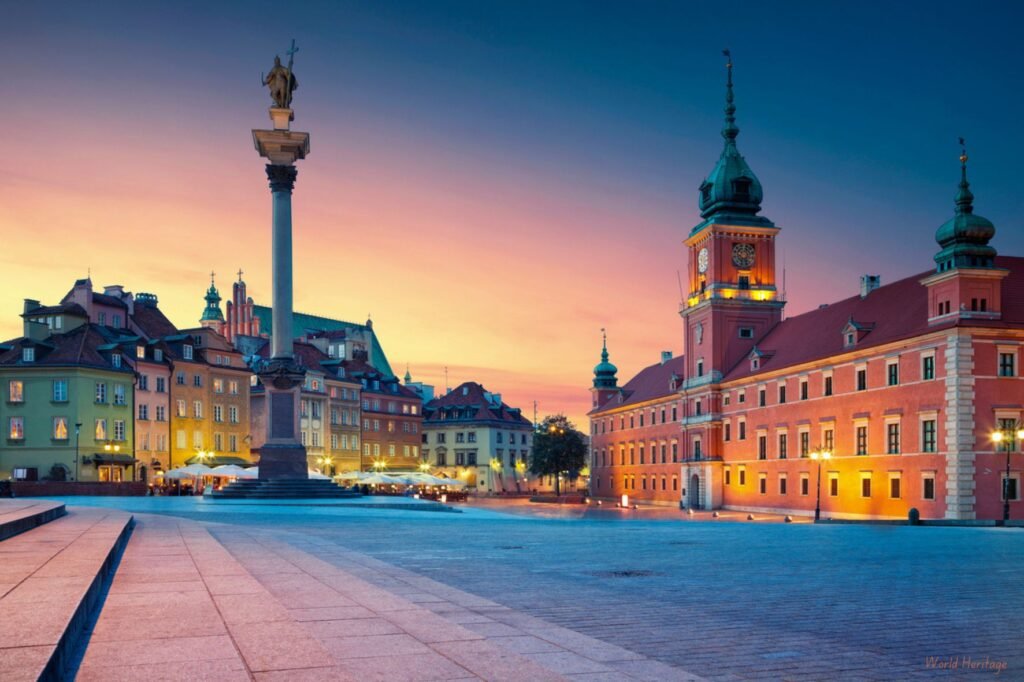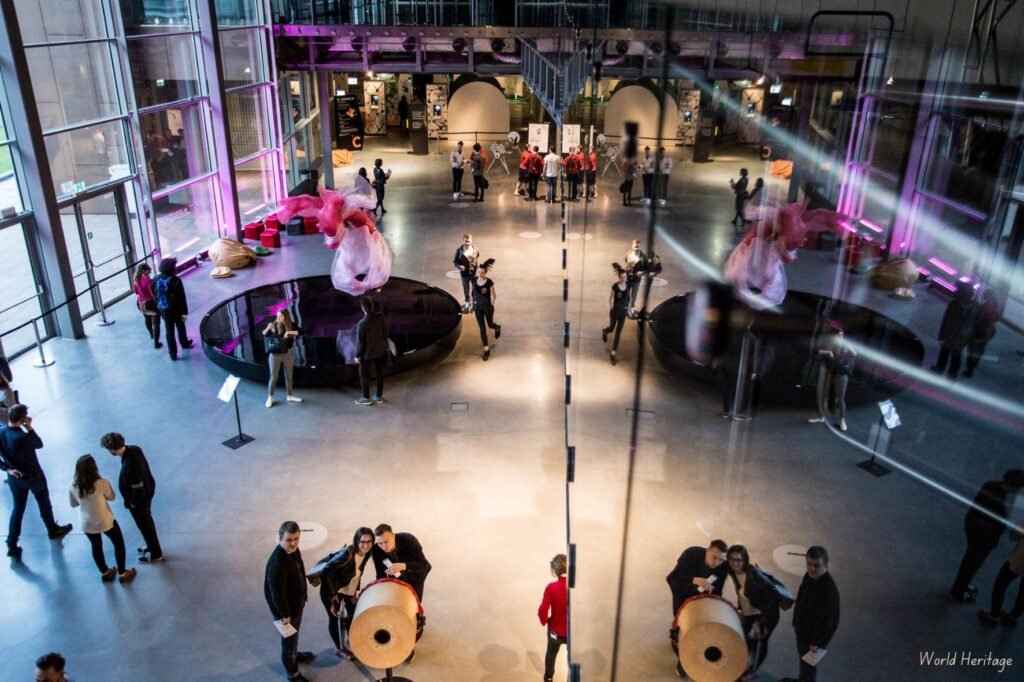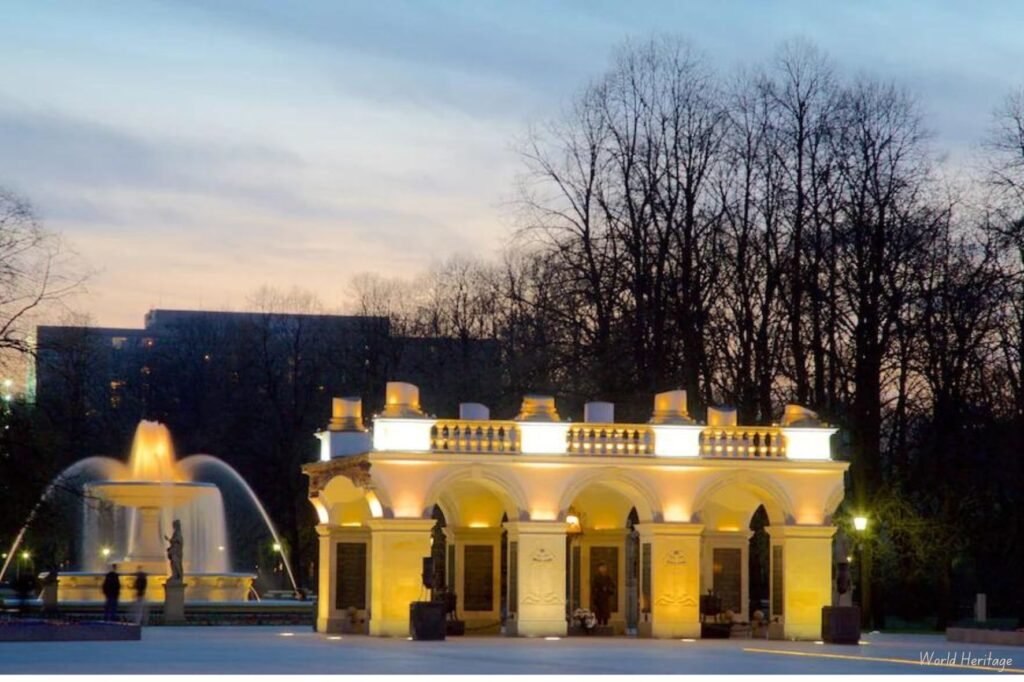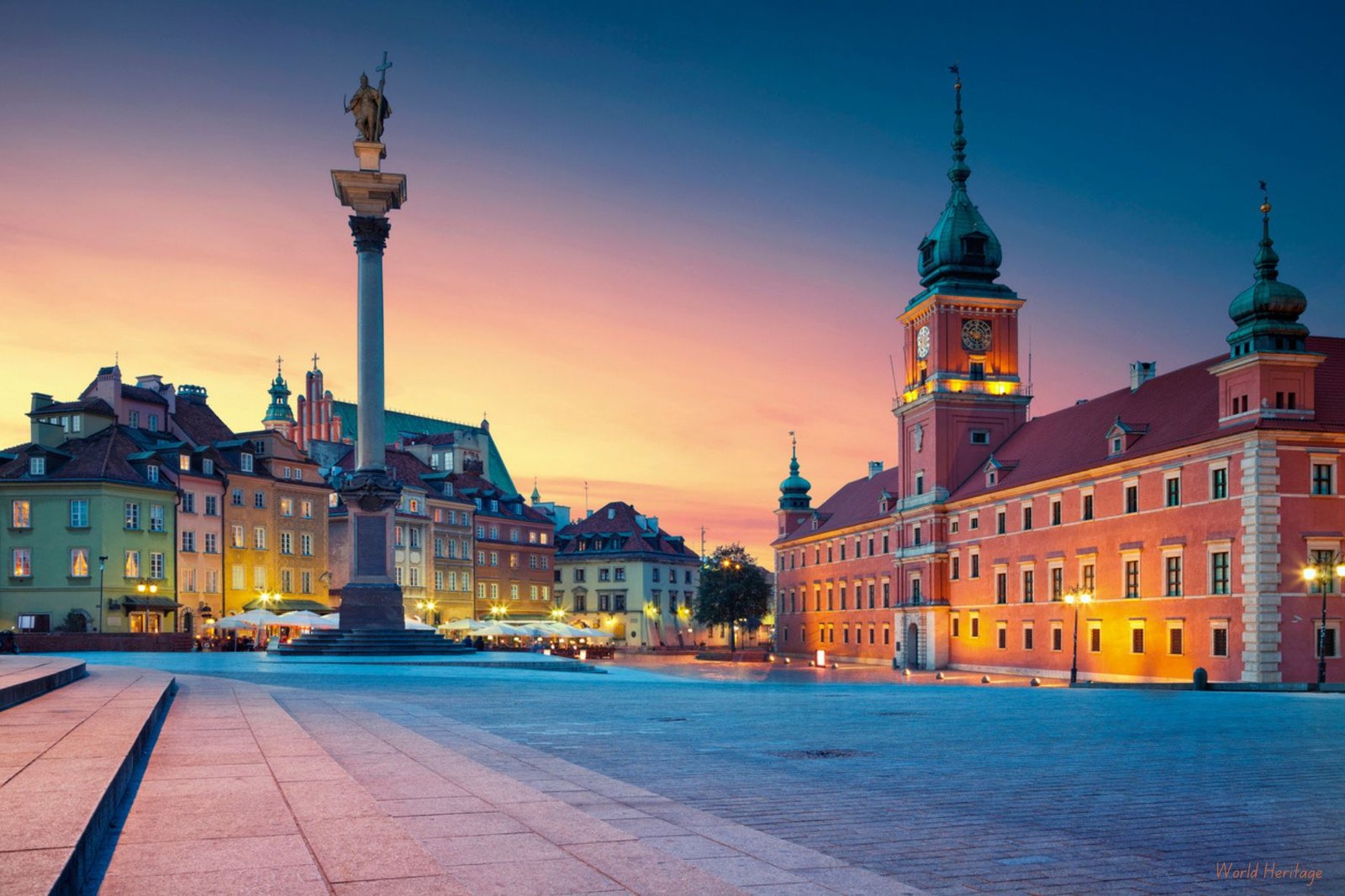
15 Best Things To Do In Warsaw, Poland
1. Explore the Old Town (Stare Miasto)
Warsaw’s Old Town is like stepping into a fairy tale for anyone who loves history or just wants to explore something magical. This part of the city is super special because it’s a UNESCO World Heritage site, meaning it’s recognized around the world as a really important place.
After World War II, when a lot of the buildings were destroyed, people worked really hard to rebuild everything exactly how it was before. Now, the Market Square is at the heart of the Old Town, and it’s where you can see the Warsaw Mermaid statue, which is the city’s symbol.
Every building around the square has its own story. Some are really colorful and used to belong to important people called burghers, while others are huge churches with amazing details inside. If you want to learn even more about what happened here long ago, you can visit the Historical Museum of Warsaw.
Even though the Old Town is really old, it’s still buzzing with life! There are lots of cool cafes, yummy restaurants, and cute shops where artisans make and sell beautiful things. People here really care about keeping everything just right, so they make sure the buildings stay looking great and put up signs that tell you all about the history of each place.
All year round, the Old Town hosts fun events and festivals where you can hear Polish music, try delicious food, and see beautiful art that’s made right here. It’s a place where the past meets the present, and there’s always something new and exciting to discover!
2. Pay Respects at the Warsaw Uprising Museum

The Warsaw Uprising Museum is a place you really should see if you want to learn about how brave the Polish people were during World War II. It’s all about what happened in 1944 when the people of Warsaw fought against the Nazis. Inside the museum, you can touch things, listen to stories, and see real objects from that time. It helps you feel like you’re part of history.
The stories and things in the museum show how strong and brave the people of Warsaw were, even when things were really tough. It’s not just a museum with things to look at – it’s a place to remember and think about what happened. You can learn a lot about the uprising and why it was so important.
The museum also teaches us about how Warsaw was almost destroyed but then rebuilt after the war. They have cool things like a ‘Freedom Park’ and a special 3D movie that shows what the city looked like after the war.
Every year, on the anniversary of the uprising, the museum helps the whole city remember the people who died fighting for their freedom. It’s a special place where you can learn a lot and remember how brave people can be when they work together.
3. Relax in Łazienki Park
Łazienki Park is the biggest park in Warsaw and a great place to relax away from the city’s busy streets. It used to be the palace and gardens of Poland’s last king, Stanisław August Poniatowski. The park is huge, covering almost 80 hectares, and it’s full of beautiful gardens, a pretty lake, and old buildings like a Roman-style theater, the Orangery, and the cute Myslewicki Palace. The best part is the Palace on the Isle – it looks like it’s floating on the water and inside, there’s a museum with things that belonged to kings and queens.
People really care about keeping the park healthy and safe for animals, like colorful peacocks and red squirrels. It’s a place where nature is protected, and you can see lots of different plants and animals living peacefully.
Łazienki Park isn’t just for relaxing – it’s also a place for fun things to do. In the summer, on Sundays, there are free concerts near a statue of the famous composer Chopin. People love these concerts because they get to hear beautiful music in a place that’s full of history and nature. It’s a special place where you can enjoy being outside and learn about Poland’s past all at once.
4. Visit the Royal Castle
The Royal Castle in Warsaw is a really special place at the beginning of the Old Town. Long ago, it was where Polish kings and queens lived, but during World War II, it got destroyed. People worked really hard to fix it up and make it look just like it used to. Now, when you go inside, you can see where the kings used to have big meetings, where they slept in their fancy rooms, and the Canaletto Room with paintings by an artist from Venice named Bernardo Bellotto.
There’s more to the Castle than just history – it’s a symbol of how strong and proud Polish people are. They all came together to fix it, which shows how much they care about their country’s past. Today, the Castle isn’t just for looking at old things; they have fun programs for kids to learn about art and history. They also have talks about Poland’s past, so kids can understand why it’s important to know where we come from.
The Royal Castle is a place where history comes alive, and it’s a reminder of how brave and determined people can be.
5. Dive into Science at the Copernicus Science Centre

The Copernicus Science Centre is an awesome place for families and anyone who’s into science. You can try out a bunch of exhibits where you get to touch and play with stuff that teaches you about space, animals, and cool experiments about our planet. And guess what? It’s not just educational – it’s really fun too!
One of the coolest things there is the Heavens of Copernicus planetarium. It’s super high-tech and one of the best in Europe. They show these incredible space shows that will blow your mind!
The Science Centre also works hard to help people understand science better. They team up with teachers and scientists to put on workshops and special events like ‘Researchers’ Night’ and ‘Science Picnics’. These events are huge and happen outdoors, so everyone can come and learn about science in a really fun way. They even talk about how science can help us live better and take care of our planet.
The Copernicus Science Centre is all about exploring and finding out new things. It’s a place where science is exciting and hands-on, and you’ll leave knowing more about the world around you!
6. Marvel at the Wilanów Palace
Wilanów Palace is like a grand masterpiece often called “The Polish Versailles.” It used to be where King Jan III Sobieski lived, and it’s been through a lot over the years – wars, changes in who ruled Poland, and more – but it’s still almost exactly how it was back then.
Inside, the Palace is famous for its beautiful rooms where the kings and queens lived, and it has a huge art collection with paintings and things from Europe and Asia. Outside, the gardens are really special too. They’re a mix of formal Baroque style and later English gardens, so there’s lots of space to explore.
The people who take care of the Palace work really hard to keep everything looking just right. They fix up old parts and make sure everything is safe. They also have fun things for people to do there, like concerts with classical music and special art shows. They even teach kids about history and art with cool classes and games, and sometimes they even have classes on how to act like a royal!
Wilanów Palace is a place where you can learn a lot about Poland’s past while having a great time exploring a real royal palace!
7. Immerse Yourself in Art at the National Museum
The National Museum in Warsaw has the largest art collection in all of Poland, with over 830,000 pieces of art from different times and styles. When you visit, you can explore rooms filled with art from the Middle Ages, paintings by Polish artists, and famous European artworks by painters like Rubens and Renoir. One of the coolest parts is the Faras Gallery, which has one of the world’s biggest collections of Nubian Christian art – that’s really important in the art world!
But the museum isn’t just a place to keep art safe – it’s also a place to learn about it. They have programs for everyone, from fun tours for kids to interesting talks for grown-ups. Sometimes, they even team up with museums in other countries to put on big exhibitions that show Polish art around the world and bring art from other places to Warsaw.
One night every year, they have something called ‘The Night of Museums,’ when the museum stays open late into the night. It’s a really fun way for lots of people to come and see art and learn about history in a different way.
The National Museum isn’t just about seeing art – it’s about learning and going on adventures to discover the stories behind the paintings and sculptures!
8. Learn at the POLIN Museum of the History of Polish Jews
The POLIN Museum is a remarkable tribute to the long history of Jews in Poland. It’s located in Muranów, where the Warsaw Ghetto used to be, and it’s housed in a really amazing building. Inside, the museum takes you on a journey through a thousand years of Jewish life – from when it was thriving in Poland and Lithuania to the terrible times of the Holocaust and beyond.
The museum does a lot to help people learn and understand. They have workshops, debates, and events that everyone can join in, where they talk about things like diversity, tolerance, and respect. The museum shows how Warsaw cares about remembering its Jewish past, and it reminds us all about important lessons from history and why it’s so important to understand and get along with each other.
The POLIN Museum isn’t just a museum – it’s a place that teaches us to remember and learn from the past, so we can build a better future together.
9. Take a Scenic Walk Along the Vistula River
The Vistula River is like the heartbeat of Warsaw, flowing past many of the city’s coolest places. It’s not just beautiful to look at – there’s tons to do along its banks. The Vistula Boulevards are super popular now because they’ve been made really nice for walking, with more space for people and less for cars. It’s one of the best spots in town to chill out, take a stroll, or even go on a boat ride to see the city from the water.
People in Warsaw really care about the environment, so they’ve been working hard to keep the river clean and safe. In the summer, you can hang out on the Vistula’s beaches, which is pretty special for a big city. And when it’s winter, some brave folks even take icy swims!
The river isn’t just for relaxing – it’s a place where cool stuff happens too. They have this awesome show at the ‘Multimedia Fountain Park’ with water, lights, and music all mixed together. It’s a great way for everyone to have fun together and enjoy nature right in the middle of the city.
The Vistula River is more than just water – it’s a place where Warsaw comes alive with fun, nature, and good times!
10. Witness the Changing of the Guard at the Tomb of the Unknown Soldier

The Tomb of the Unknown Soldier is a solemn place where we honor all the soldiers who sacrificed their lives for Poland’s freedom. You can find it in Saxon Garden, which is the oldest park in Warsaw. The tomb is the only part left from the Saxon Palace, which was destroyed during World War II. Every hour, visitors can watch a special ceremony called the Changing of the Guard. Polish soldiers perform this ceremony to pay tribute to those who bravely fought for their country.
This ceremony is really important because it helps us remember the past and appreciate the courage of people who lived through the wars of the last century. The soldiers perform their duties with great care and respect, showing how much they value Poland’s history. The park around the tomb is also very beautiful, with traditional gardens and statues that inspire reflection.
Saxon Garden isn’t just a park – it’s a place where history is alive, and you can see some of the oldest and most unique trees in Warsaw. It’s a peaceful place where we can learn about the past while enjoying the beauty of nature.
11. Indulge in Polish Cuisine at a Traditional Milk Bar
Visiting a traditional Polish ‘Milk Bar’ is like taking a tasty journey into the food and history of Warsaw. Milk Bars, also known as ‘Bar Mleczny,’ started during the time when Poland was communist. They are cafeterias where you can get simple and filling Polish food that’s also affordable.
At a Milk Bar, you can try lots of Polish favorites like pierogies (dumplings), kotlet schabowy (breaded pork cutlet), and barszcz (beetroot soup). These places are not fancy, but they’re really special because they’ve kept their old-fashioned charm and are loved by lots of different kinds of people in Poland.
Milk Bars have stayed popular not just because they’re cheap, but because people have worked hard to keep them alive as a part of Polish culture. In recent years, they’ve become popular again with older folks who remember them, tourists who want to try something traditional, and younger people who like good food that doesn’t cost a lot. Milk Bars are like living museums of Polish food and culture, where you can taste history and see how people used to eat in Poland.
12. Enjoy the Views from the Palace of Culture and Science
The Palace of Culture and Science is a big and famous building that you can’t miss in Warsaw. It was given as a ‘gift’ from the Soviet Union in the 1950s and shows off a style of architecture called Socialist Realism. It’s also the tallest building in Poland. Some people really like it, and some don’t, but everyone agrees it’s a big part of Warsaw’s look.
On the 30th floor, there’s a terrace where you can see amazing views of the whole city. It’s a great spot to look at Warsaw’s history and all the different kinds of buildings from way up high.
Inside the Palace, there are theaters, a movie theater, museums, and a big room for meetings. They’ve been making the building more friendly to the environment by saving energy and being careful about how they take care of it.
All year long, the Palace has lots of cool events and markets where people can see shows and buy things. It shows how lively Warsaw is and how much the people in the city like this building.
13. Shop and Stroll on Nowy Świat
Nowy Świat is one of Warsaw’s most famous and classy streets, part of the Royal Route. It’s always busy with stylish shops, cute cafes, and nice restaurants. The street is really cool because it mixes old buildings with new ones, so you see both history and modern stuff all together.
Walking along Nowy Świat lets you feel the city’s busy life and see how things were in the past too. Sometimes, they close parts of the street to cars, which makes it even better for tourists to visit. There are always fun things happening, like decorations for different times of the year and events with music and markets where people sell handmade things.
They really take care of the old buildings here, so they look nice while people enjoy shopping in the stores. Nowy Świat shows how Warsaw can keep its history and still be a cool place for shopping and hanging out.
14. Get Cultured at the Grand Theatre
The Grand Theatre in Warsaw is one of Europe’s biggest theaters and home to the Polish National Opera and the National Ballet. It’s a beautiful neo-Renaissance building in Theater Square. During World War II, it was damaged, but it’s been fixed up wonderfully since then. Watching a show here isn’t just about seeing great cultural performances – it’s also about being in a theater that’s super fancy inside.
They have all kinds of shows at the Grand Theatre, like operas, ballets, and concerts with orchestras. They’ve made it easier for people who speak different languages to enjoy the shows by putting English subtitles on the screen for visitors from other countries. The Theatre also does a lot to make sure everyone can learn and enjoy art, with classes for kids and big events like the International Stanisław Moniuszko Vocal Competition. These things show how much they care about music and getting people excited about classical arts.
The Grand Theatre is a special place in Warsaw where you can see amazing performances and learn a lot about music and dance.
15. Challenge Yourself at the Invisible Exhibition

The Invisible Exhibition is a special interactive display where visitors are challenged to explore rooms in total darkness, guided by people who are visually impaired. This unique experience makes you think differently because you have to use your senses other than sight to understand what’s around you. It helps you understand the daily life of people who can’t see well and learn about the challenges they face.
This exhibition is part of a worldwide effort to include everyone in society and show how capable people with disabilities are. Taking part in the tour not only gives you personal insights but also supports the visually impaired guides by providing them with jobs and showing their skills. There are also programs and classes that talk more about including everyone and making things easier for people with disabilities when you visit the exhibition. It’s a journey that helps you learn and change the way you see diversity.
Warsaw is a city with a lot of history and cool new stuff to see. It has so much to offer, from fun things to learn about to places that inspire you. If you want to stay in Warsaw and care about the environment, ETIC Hotels has places to stay that are good for the planet. You can enjoy all the charm and strength of Warsaw while knowing you’re staying somewhere that cares about the Earth.
Here are frequently asked questions about Warsaw, Poland:
- What is Warsaw famous for?
Warsaw is famous for its history and how it rebuilt after World War II. It’s also known for its music, art, and books. - What are the best places to visit in Warsaw?
Some of the coolest places in Warsaw are the Old Town (Stare Miasto), the Royal Castle, Lazienki Park, the Warsaw Uprising Museum, and the Palace of Culture and Science. - Is Warsaw safe for visitors?
Yes, Warsaw is safe for visitors. Just like in any big city, it’s smart to be careful at night and keep an eye on your things in crowded places. - How can I get around Warsaw?
Warsaw has buses, trams, and a subway (metro) that make it easy to get around. You can also take a taxi or use ride-sharing services. Lots of places in the city are also good for walking, especially in the middle. - What kind of Polish food should I try in Warsaw?
You’ve got to try pierogi (dumplings), bigos (hunter’s stew), kotlet schabowy (breaded pork cutlet), and barszcz (beetroot soup). You can find these in traditional Polish restaurants and Milk Bars. - Are there any cool trips to take from Warsaw?
Yes! You can take day trips to places like Krakow (a historic city), Lublin (a medieval town), or Auschwitz-Birkenau (a former concentration camp).
Pros and cons of visiting Warsaw, Poland:
| Pros | Cons |
|---|---|
| Rich History: Visit places like the Old Town and Royal Castle. | Weather: Cold winters and sometimes hot summers. |
| Fun Culture: Enjoy museums, theaters, and festivals. | Crowds: Lots of tourists, so it can be busy. |
| Good Prices: Things are usually cheaper than in Western Europe. | Language: Not everyone speaks English outside tourist spots. |
| Easy Travel: Buses, trams, and the metro make it easy to get around. | Rebuilt Areas: Some places look newer because they were rebuilt after World War II. |
| Day Trips: You can easily visit other cool cities nearby. | Traffic: Sometimes there’s a lot of cars, especially during busy times. |
Conclusion
Visiting Warsaw, Poland offers an exciting adventure into its history, culture, and lively city atmosphere. The city has bounced back from challenges, as seen in its rebuilt Old Town and Royal Castle, which give a peek into its fascinating past. Warsaw celebrates its diversity through museums, theaters, and festivals that entertain and educate people of all ages.
Getting around Warsaw is easy with its excellent public transportation system, making it simple to visit both historic sites and modern attractions. Compared to Western Europe, Warsaw is affordable, and nearby cities like Krakow and Gdansk are easily accessible for day trips.
However, visitors should be ready for varied weather, with cold winters and sometimes hot summers. Warsaw can get busy with tourists, especially during popular times, and not everyone speaks English outside tourist spots. Despite parts of the city being rebuilt after World War II, Warsaw maintains a unique mix of old and new, blending historical charm with modern conveniences.
In summary, Warsaw warmly welcomes visitors to explore its rich history, diverse culture, and friendly atmosphere, ensuring an unforgettable journey through Poland’s lively capital city.
